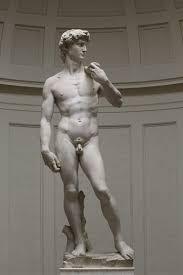David is one of Michelangelo’s most recognizable works and has become one of the most recognizable statues in the world of art. It is a masterpiece of the Renaissance era and was created between 1501 to 1504. This 5.17-meter statue represents the biblical hero David.
How Does the Statue of David represent Humanism?

Michelangelo became the first one who chose to portray David before the battle. David is tense, and Michelangelo catches him at the apex of his concentration. He is portrayed as a nude man with a very muscular physique. His face conveys intense concentration and a furrowed brow as he stares into the distance. This depiction is trying to show the audience that he is engaged in the battle.
His veins are visible in his arms and hands as he clutches the stones with one hand and the slingshot with another. His hands and head appear to be disproportionally large for his body. Possibly because they were deemed more visually important for viewers who would see the statue high up on the exterior of the cathedral.
His left leg, which straddles the rocky base upon which he stands appears too big and too long for his body. It accentuates the line of this leg as it forms an essential component in David's contrapposto stance.
Like ancient Hellenistic and Roman sculptures who were masters at convincingly depicting the human anatomy, Michelangelo has depicted David so that his body responds to the stance he is in. David’s weight has been placed on his right leg while his left leg is at rest. His hind has shifted with one side being higher than the other. In turn, this has caused David’s spine and midsection to curve slightly, and his right shoulder drops slightly below his left one.
History of the Statue
One of the most interesting facts that have made the Statue of David famous is the fact that it was carved from a single block. The block of marble has lied abandoned for twenty-five years in the courtyard of Opera del Duomo because the artist that was commissioned to work with the marble had too many imperfections. The block came from quarries in Carrara.
Michelangelo was later hired to complete the project. The sculpture was to be a series of statues depicting old testament figures which will be placed in the Cathedral of Florence.
When he was presented with the project, he was already one of the best-paid artists in Florence. He worked constantly for over two years to create David. He worked in absolute secrecy and hid his masterpiece until January 1504. It was said that he worked in the open and when it rained, he was working while he was soaked.
His biographer Ascanio Condivi reported that he slept sporadically and slept with his boots and clothes still on. Michelangelo used a very interesting method of work for the David statue. He created a wax design and submerged it in water. As he worked, he would see the water level drop, and using different chisels sculpted what he could see emerging.
After two years of hard work, he presented the statue to the members of the vestry board and to Pier Soderini. In January, his statue was only revealed to them. All of them agreed that it was too perfect to be placed in the Cathedral and decided to discuss another location in town.
The city council later made a committee of thirty members. This includes artists of that era, such as Sandra Botticelli, Giuliano de Sangallo, and Leonardo da Vinci to decide the most appropriate site for the statue. During the discussions, nine different locations were proposed but in the end, it was decided to be placed in the heart of political significance in Florence, Piazza Della Signoria.
It took four days and forty men to move the statue half a mile from his workshop behind Santa Maria del Fiore Cathedral to the Piazza Della Signoria. They pushed the statue using a wooden cart and secured the statue with ropes. It arrived on signoria square on June 8th, 1504, and was installed next to the entrance of Pallazzo Vecchio. It replaced Donatello’s bronze sculpture of Judith and Holofernes.
Biblical significance

Why was the Statue of David important? The statue of David is a famous party due to its portrayal of the battle between David and Goliath is recorded in Book 1 Samuel. It was told that Saul and the Israelites were facing the Philistines near the valley of Elah. Twice a day for forty days, Goliath, the champion of the Philistines would come out between the line and challenges the Israelites to send out a champion of their own to decide the war’s outcome through one-on-one combat.
Only David, a young shepherd accepts the challenge. Saul reluctantly agrees and offers him his armor, which David declines since it was too large for him to carry. He took his slings and five stones from the brook.
When David and Goliath confronted each other, Goliath with his armor and shield, and David armed with rocks, slings, and his faith in God and his Courage. David hurls his stone from his sling with all his might and hits Goliath in the center of his forehead. Goliath falls on his face to the ground. David took the opportunity to cut his head off.
Traditionally, David has been portrayed after his glory. His demeanor is triumphant after succeeding to slain the giant. Florentine artists like Ghiberti, Donatello, and Verrochio have depicted their own version of David standing over Goliath’s severed head.
The statue itself has more similarities to Donatello’s David. Both are heroic nudes standing in contrapposto though Donatello dressed his David with boots and a hat. He portrayed David as a semi-effeminate boy. Michelangelo, however, decided to portray David as a strong and assured man stripped of all other objects associated with the biblical narrative such as Goliath’s head or the sword. Instead, David stands alone with only his slingshot and stones hidden in person.
Whether you are an art lover or simply curious about history, learning more about the Statue of David is a fascinating journey. From its creation to its restoration, there are many fun and interesting facts that you may not know about this iconic masterpiece. In this article, we will explore some of the most surprising and entertaining details of the Statue of David's history and legacy.




